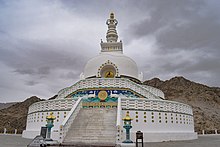Shanti Stupa, Ladakh
| Shanti Stupa | |
|---|---|
 | |
| Religion | |
| Affiliation | Tibetan Buddhism |
| Location | |
| Location | Chandspa, Leh district Ladakh, union territory of india, India |
| Country | India |
| Geographic coordinates | 34°10′25″N 77°34′29″E / 34.17361°N 77.57472°E |
| Architecture | |
| Founder | Ladakh Shanti Stupa Committee under Bhikshu Gyomyo Nakamura[citation needed] |
| Date established | 1985 |
Shanti Stupa is a Buddhist white-domed stupa (chorten) on a hilltop in Chanspa, Leh district, Ladakh, in the north India.[1] It was built in 1991 by Japanese Buddhist Bhikshu, Gyomyo Nakamura and part of the Peace Pagoda mission. The Shanti Stupa holds the relics of the Buddha at its base, enshrined by the 14th Dalai Lama.[2] The stupa has become a tourist attraction not only due to its religious significance but also due to its location which provides panoramic views of the surrounding landscape.
Construction
The Shanti Stupa was built by both Japanese Buddhists and Ladakh Buddhists. Original idea was stated by Nichidatsu Fujii (Fujii Guruji) in 1914.[3] The mission of Nichidatsu Fujii was to build Peace Pagodas and temples over the world and try to resurrect Buddhism back in India.[3]
Construction of the Shanti Stupa began in April 1983 under the supervision of Bhikshu Gyomyo Nakamura and Kushok Bakula, a lama of Ladakh from New Delhi, member of the Minority commission of Govt of India, former statesman and former international diplomat of the Republic of India.[3] The project was built with the help of Ladakhi Buddhists, who offered voluntary labour, and Japanese Buddhists, who consider India as the "sacred" birthplace of the Buddha.[3] The then Prime Minister of India, Indira Gandhi, sanctioned the construction of a vehicular road to the stupa in 1984.[3] The state government also provided some financial assistance for the construction of the Shanti Stupa.[citation needed] The 14th and current Dalai Lama, Tenzin Gyatso inaugurated the Shanti Stupa in August 1991.[1][3][4]
Description and significance


The Shanti Stupa features the photograph of the current Dalai Lama with the relics of the Buddha at its base.[3] The stupa is built as a two-level structure. The first level features the central relief of Dharmacakra with deer on each side. A central golden Buddha image sits on a platform depicting the "turning wheel of Dharma" (Dharmacakra). The second level has reliefs depicting the "birth" of Buddha, the death of Buddha (mahanirvana) and Buddha "defeating the devils" while meditating.[5] Both levels feature a series of smaller meditating Buddha reliefs.
The Shanti Stupa was built to promote world peace and prosperity and to commemorate 2500 years of Buddhism.[1][3] It is considered a symbol of the ties between the people of Japan and Ladakh.[3]
Tourist attraction
Since its inauguration, Shanti Stupa has become a popular tourist attraction. According to The Hindu it is the "most famous tourist attraction" around Leh, though its architectural style is different from the Ladakhi style.[1][6] The Shanti Stupa overlooks the city of Leh, providing panoramic views of the city, the village of Changspa, Namgyal Tsemo in the distance and the surrounding mountains.[7][8] Sunrise and sunset are considered to provide the best views from Shanti Stupa.[9] The stupa is illuminated with lights at night. The stupa is open for tourists between 5:00 a.m. and 9:00 p.m.[9]

Access
Situated at a height of 3,609 metres (11,841 ft),[4] the stupa is located 5 kilometres (3.1 mi) from Leh - the former capital of Ladakh - on a steep hill facing the Leh Palace.[3] The stupa can be reached by a drivable road or on foot using a series of 500 steep steps to the hilltop.
A similar replica of Shanti Stupa is also built in New Delhi near Kale khan
See also
Notes
- ^ a b c d "Shanti Stupa". Buddhist-temples.com. Retrieved 19 October 2009.
- ^ "Leh". NDTV.
- ^ a b c d e f g h i j Bhasin, Sanjeev Kumar (2006). "Shanti Stupa". Amazing land Ladakh: places, people, and culture. Indus Publishing. pp. 119–20. ISBN 978-81-7387-186-3.
- ^ a b Jagir Singh Bajwa, Ravinder Kaur (2007). Tourism Management. APH Publishing. p. 117. ISBN 978-81-313-0047-3.
- ^ The titles of the reliefs are given on the plaques under the reliefs at the Shanti Stupa.
- ^ Luv Puri (21 August 2005). "Ladakh monuments cry for renovation". The Hindu. Retrieved 1 December 2009.
- ^ Frommer's India. Hoboken, NJ, USA: Wiley Publishing Inc. p. 524. ISBN 978-0-470-16908-7.
- ^ "Leh: Places to see". VISITLADAKH.COM. Archived from the original on 22 November 2019. Retrieved 1 December 2009.
- ^ a b "Shanti Stupa". Buddhist-Tourism.Com. 2007. Archived from the original on 2 July 2007. Retrieved 1 December 2009.

